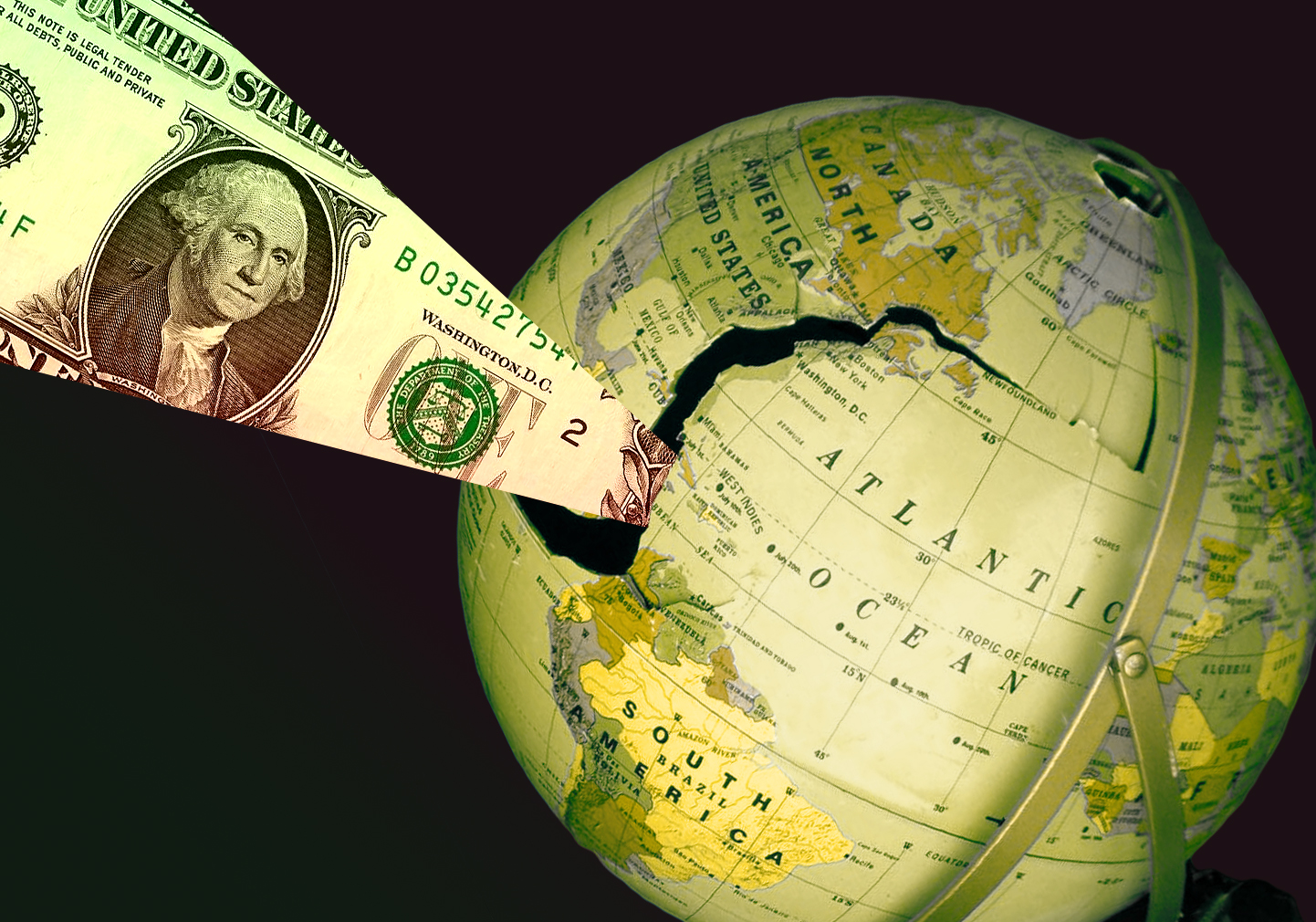In May 2022, the CEO of BlackRock declared that “the Russian invasion of Ukraine has put an end to the globalisation we have experienced over the last three decades”. He undoubtedly has a point. The war in Ukraine has brought to a head the conflicts that have been brewing between the major powers for some time.
This development needs an explanation. The bourgeois commentators bemoan our impending doom and the shortsightedness of politicians. But there is little point in this kind of hand-wringing. One cannot understand the world in terms of ‘policy choices’ and similarly useless terminology. Rather, we must try to understand the contexts in which free trade (which is the real content of globalisation) and protectionism develop. Globalisation has to be understood as a process, which was brought about by certain conditions; conditions that are no longer there.
How world trade has transformed the world
Back in the early 2000s, globalisation and free trade were in fashion. Liberals and conservatives alike worshipped at the altar of Adam Smith. The Wealth of Nations was considered the most profound thing ever written.
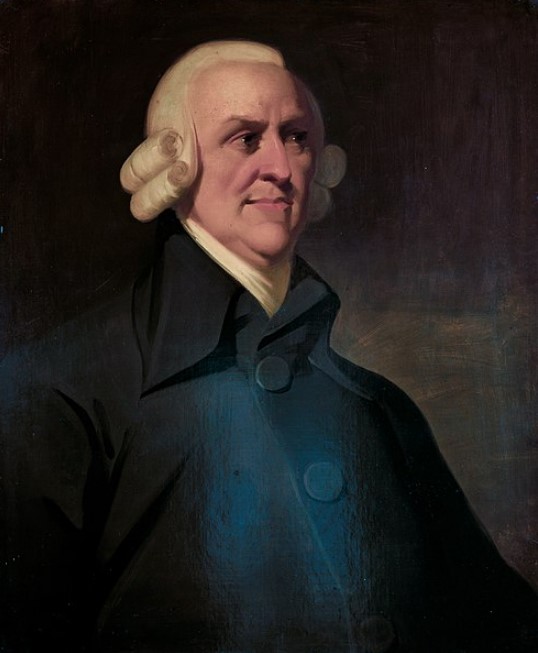 Until recently, Adam Smith's conception of free trade was very much in fashion / Image: Public Domain
Until recently, Adam Smith's conception of free trade was very much in fashion / Image: Public Domain
Their admiration for free trade had a certain justification. World trade has transformed the world, and for the better. The productive forces have burst the limits of the nation state. The world has become interconnected in a way that it has never been before. Supply chains have connected nations, industries and workers across the world.
With the growth of world trade, productivity also rose. The industries in the advanced economies produced increasingly advanced goods, and even former colonial countries began developing significant bases of industry, in particular in China, of course, a country we will return to later on.
World trade cheapened raw materials by shifting production or extraction to those places where they were most accessible, as Adam Smith had foreseen. Why not extract iron ore in the Australian outback where it costs $30 per tonne, rather than in China where it costs $90 per tonne?
Likewise, only the combination of all the resources of the world could create modern technology. Take cobalt, for example. Half of the world’s reserves and production are to be found in the Democratic Republic of Congo. One third of the world’s nickel is produced in Indonesia, and half of the world’s lithium is produced in Australia. These materials are all essential components of lithium batteries.
Furthermore, by concentrating production in huge factories that serve the world market, tremendous economies of scale can be achieved. The Foxconn iPhone assembly line in Shenzhen, for instance, is capable of outputting 100,000 iPhones per day. This is a far cry from capitalism’s early years, when production was carried out by handloom workers, weaving, powered by nothing more than the individual workers’ own muscles and skill.
In just the last 30 years, the Chinese economy has been completely transformed. The number of workers involved in the primary sector (mining, agriculture, etc.) fell from 60 to 34 percent, whilst the share of industrial workers increased from 20 to 34 percent, which means that China now has one of the highest shares of industrial workers in the world. The value added per industrial worker in Chinese industry increased tenfold in US dollar terms between 1991 and 2019, although it remains only one fifth of that produced by US workers.
The worldwide division of labour massively increased the productivity of labour and made possible the production of cheap commodities, including the provision of mobile phones all over the world. Even in a poor country like India, today there are 84 mobile phone subscriptions per 100 people (up from one in 2001). This massive improvement in the productivity in industry has also allowed an increasing share of the population to dedicate their working hours to the service sector, healthcare and education, as well as tourism and hospitality.
The whole period following the Second World War witnessed a massive expansion of world trade, starting in the 1950s and 1960s, which continued to soar thereafter. In 1970, the ratio of world trade to world GDP was 13 percent – in other words, approximately an eighth of all goods and services were produced for export. By 1980, this figure had reached 21 percent. In the 1990s, there was another spurt of growth up to 24 percent, and by 2008 it reached 31 percent.
Political developments followed alongside economic development. The General Agreement on Tariffs and Trade (GATT) was concluded in 1947 by 20 countries. This was followed by multiple further agreements among the signatories throughout the 1950s and 1960s, as well as an increase in the number of signatories, from 20 in 1949 to 37 in 1959, to 75 by 1968. By the time the World Trade Organisation (WTO) was created in 1994, GATT had 128 signatories.
The WTO itself included a far more comprehensive trade agreement including services; a dispute settlement mechanism; agreements on the protection of intellectual property, etc. On average, trade tariffs fell from 22 percent in 1947, to 5 percent at the time of the creation of the WTO.
This was made possible by the massive expansion of the world economy that took place after the Second World War, meaning that even if you had to cede some ground to your competitor or close down some of your industry, the overall increase in the world markets would leave you significantly better off. In this period, the dynamic of free trade really worked in the way Adam Smith and David Ricardo (who developed Smith’s ideas) suggested it would. The looming dominance of the US over the capitalist world pushed a free trade agenda onto reluctant participants, smoothing over the whole process.
In the 1990s, the International Marxist Tendency (IMT) produced a document that explained this process:
“The fact that we have entered an entirely new situation on a world scale is shown by the changed role of world trade. The massive development of world trade in the period 1948-73 was one of the main reasons for the post-war upswing in world capitalism. This enabled capitalism—partially and for a temporary period—to overcome the main barriers to the development of the productive forces: the nation state and private property.” (A New Stage in the World Revolution)
This is what was known as globalisation, i.e. a massive expansion of the world market to overcome the limitations of the national markets. In other words: the limits of the nation state.
The nation state
At this point, it is necessary to consider how the nation state relates to the development of capitalism. When capitalism emerged onto the scene of world history it overcame regional, feudal limitations, to create a national market. The peculiarities of isolated markets around market-towns and regional capital were overcome, and prices were established through competition on a national scale between farmers and companies. This national market was the key to the development of capitalism in the first centuries of its existence.
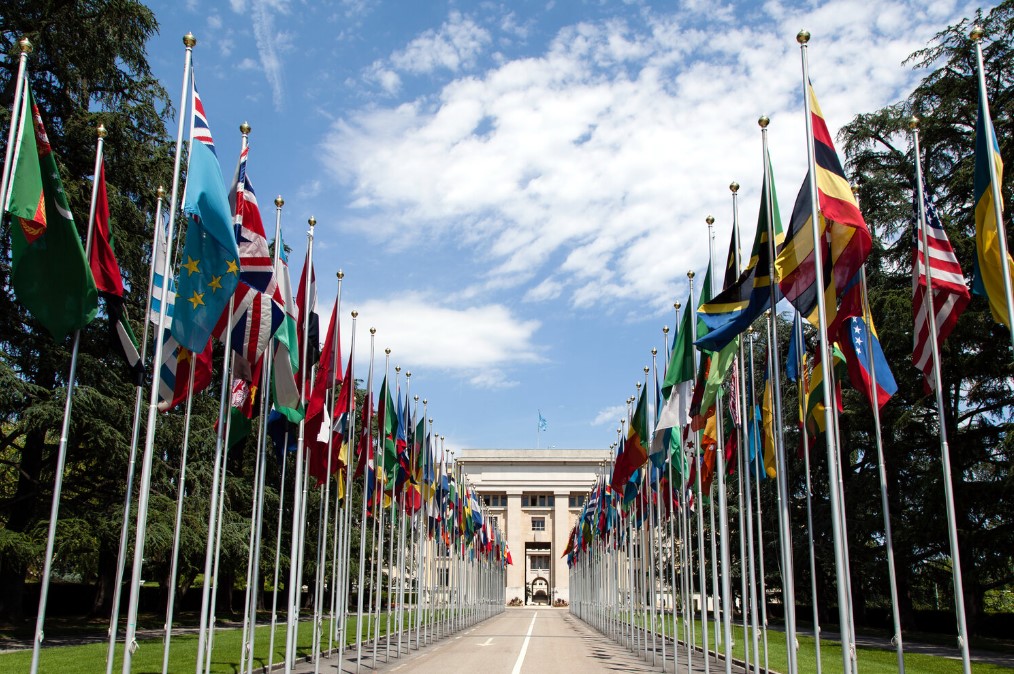 The nation state was the key to the development of capitalism in the first centuries of its existence / Image: Wikimedia Commons
The nation state was the key to the development of capitalism in the first centuries of its existence / Image: Wikimedia Commons
But as capitalism developed the productive forces, competition gave way to monopoly. The handloom gave way to the power loom, and ‘barriers to entry’, as the economists call them, became greater. To start a weaving mill, you now needed not just a workshop and some handlooms, but a factory, a steam engine and power looms. The development of the productive forces, i.e. the development of new technology and its application to production, almost always leads to greater monopolisation, i.e. the concentration of more capital in the hands of fewer capitalists.
Once the monopolies have dominated and exhausted the domestic market, they are forced to seek out other outlets for their products. This leads to a massive expansion of the world market and world trade. Yet this too ceases to be sufficient at a certain point. The monopolies also need to find new outlets for their accumulated profits. Capital seeks new profitable investments, no longer available on the domestic markets. This is the beginning of the export of capital.
Capital is exported by means of finance capital (banks, insurance companies etc.), which comes to dominate the domestic and the world market. This is the world that Lenin described in his work, Imperialism: the Highest Stage of Capitalism. This is also the world that we live in today, although on an even higher level.
Lenin explained that the narrow, limited borders of the nation hem in the productive forces, which each capitalist nation is forced to attempt to overcome. Therefore, as the productive forces developed during the 20th century, world trade developed far quicker.
The consequences were tremendous:
“The intensification of the international division of labour, the lowering of tariff barriers, and the growth of trade, particularly between the advanced capitalist countries acted as an enormous stimulus for the economies of the national states. This was in complete contrast to the dismemberment of the world economy in the period between the Wars, when protectionism and competitive devaluations helped to turn the slump into a world depression.” (A New Stage in the World Revolution)
Furthermore, the upswing of the post-war period was both the cause, and the effect of the development of world trade.
Protectionism
Protectionism, the polar opposite of free trade has, of course, also existed throughout the history of capitalism, and for very good reasons.
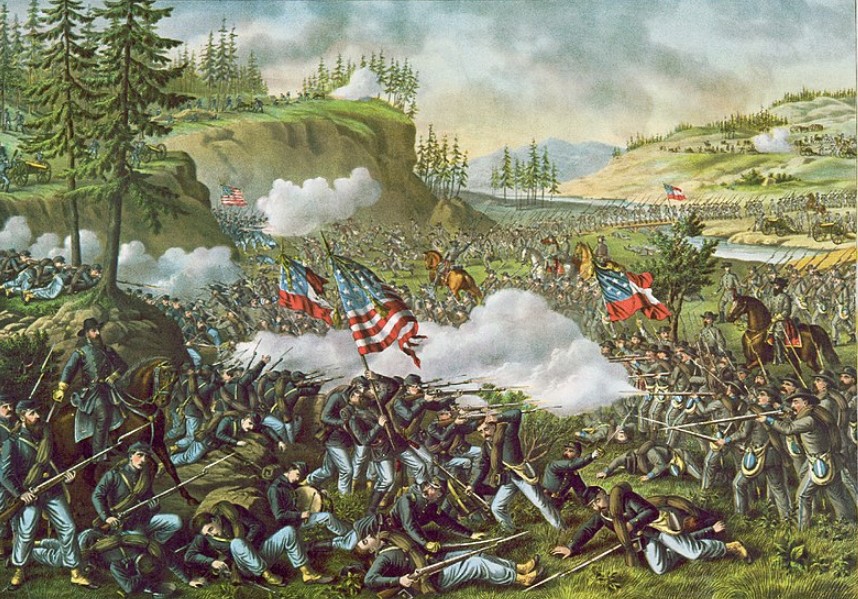 The issue of free trade vs protectionism was also a key factor in the US Civil War / Image: Library of Congress
The issue of free trade vs protectionism was also a key factor in the US Civil War / Image: Library of Congress
By the mid-19th century, British industries reigned supreme on the world market. Using cheap commodities, they conquered the world. This was the era of British free trade. It was reflected in the domination of the Whigs in the British Parliament, and the repeal of the tariffs on grain, known as the Corn Laws. Thus, food for the working class was cheapened, enabling the bosses to keep wages down.
However, the domination of British industry posed a problem for other nations whose industries were far less developed. They needed some means of shielding their industries from British competition. As Engels put it, these nations “did not see the beauty of a system by which the momentary industrial advantages possessed by England should be turned into means to secure to her the monopoly of manufactures all the world over and forever.” (Engels, “The French Commercial Treaty”, 1881)
In Sweden for example, they introduced a system of export restrictions. The British industries were drawing in ever increasing amounts of raw materials. But supplying Britain with unprocessed logs, iron ore and other minerals would do little to develop Swedish industries. Therefore restrictions were put in place on exports of pig iron, iron ore and logs, in order to ensure that the processing took place in Sweden. When the Swedish metal and wood industry caught up, the restrictions were lifted, and Sweden entered a free trade agreement with Britain and France.
Similarly, the cotton-producing Confederates during the US Civil War were free-trade advocates. They wanted lower barriers to export raw cotton to England. The industrial north, however, favoured protective tariffs to protect its industries from their English counterparts. Slavery was therefore intimately connected with economic backwardness and free trade. Again, once the US had developed its industries, its bourgeoisie became massive proponents of free trade.
However, this development towards free trade does not flow in only one direction. By the end of the 19th century, British industries were facing increasingly stiff competition abroad, particularly from Germany and the US. This began causing a shift in the UK. The Tory Party returned to power, and started pushing an increasingly protectionist agenda. What was known as ‘imperial preference’ became one means of applying protectionism. This entailed Britain’s colonial possessions enacting preferential treatment for trade inside the British Empire. This policy was particularly targeted against the US and Germany.
This policy coincided with a turn towards land-grabbing of colonies. Lenin explained this process in Imperialism. The competition between monopolies turned into competition between nations. By 1900, the imperialist nations had carved up the world between themselves, and so any further expansion could only come at the expense of the other imperialist nations. The increasing contradictions between the capitalist powers – their battle over markets for goods and investments – were leading to increasing tensions in international relations.
As Germany had the smaller share of the colonies, its industries strained against the limitations imposed on it by its lack of colonies and access to the colonies of other nations. The German bourgeoisie needed and demanded a re-division of the world, in proportion to Germany’s newfound economic development. When the boom of the late 19th and early 20th century ended, the contradictions spilled over into world war.
There is therefore a close connection between economic crisis, protectionism, crises in international relations and war. We should remember, as Clausewitz pointed out, that war is politics by other means. And, as Lenin put it, politics itself is only concentrated economics.
The First World War solved none of the contradictions in the world economy. It only intensified them, and after the war, protectionism really took off. Britain introduced ‘Imperial Preference’ in 1932-33, bringing the policy of the colonies into line with the mainland. In 1933, President Hoover introduced the Buy American Act, which forced government contractors to use US-made products. Similar policies were enacted all around the world, contributing to a dramatic collapse in world trade by some 30 percent in the three years following the 1929 crash.
Adam Smith said that protectionist nations were “beggaring all their neighbours”, i.e. turning their neighbours into paupers, from which the phrase ‘beggar-thy-neighbour’ comes. Smith was describing attempts to cure recession and unemployment by exporting it, by shifting consumption to domestically produced goods. Of course, in a recession and especially a depression, these contradictions are exacerbated, as shrinking markets create more idle factories.
Protectionism on the rise
The crisis of 2007-8 really put an end to the further extension of free trade. The Doha Round of WTO-led negotiations was already in trouble, but the crisis finished it off. The negotiations were meant to tackle the issue of agricultural subsidies in Europe and the United States. After the collapse of negotiations, only half-hearted attempts were made to renew them. Instead, the process of rolling back world trade started.
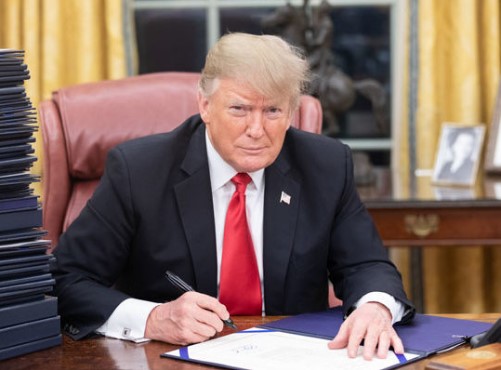 Trump is often credited with bringing back protectionism, but he was only the logical next step / Image: The White House
Trump is often credited with bringing back protectionism, but he was only the logical next step / Image: The White House
Often, Trump is credited with bringing back protectionism, but he was only the logical next step. Obama launched the slogan, “Buy American!” in 2009. The Buy American Act had remained in force ever since 1933, but had been watered down significantly by various agreements like GATT, NAFTA and the Agreement on Government Procurement. Obama beefed it up in his 2009 Recovery Act and would have gone further in his 2011 Jobs Act, if it hadn’t been for the Republicans blocking it. Both acts were heavily criticised by the EU and Canada for undermining free trade.
Trump, of course, introduced a raft of protectionist measures, particularly around steel, but he remained constrained by WTO provisions. Biden rolled back some of these measures, particularly against Europe, Japan and Canada. However, far from abandoning protectionism, he has promised to try to ‘modernise’ the WTO rules, by which he means watering them down to give the US more scope for protectionist measures. The EU, for obvious reasons, is less than enthusiastic about this proposal.
Biden’s Inflation Reduction Act (IRA) follows the precedent set by Obama. In order to qualify for a subsidy to your electric car purchase, you have to buy a car ‘Made in America’. Similarly, investments in Green Energy need to comply with the conditions of the Buy American Act, i.e. they need to source their raw materials from the US. This has really inflamed tensions between the US and the EU, who feel that the US is discriminating against its ‘allies’. Macron called for a ‘Buy European Act’ and although the Germans have taken a less confrontational approach, they have nonetheless been pressuring the US for concessions.
German Chancellor Scholtz in his typically reserved diplomatic style, wrote in Foreign Affairs:
“I believe that what we are witnessing is the end of an exceptional phase of globalisation, a historic shift accelerated by, but not entirely the result of, external shocks such as the COVID-19 pandemic and Russia’s war in Ukraine.”
In other words, globalisation as we know it is finished, and it won’t be coming back, precisely because it is not just the result of the war in Ukraine or the pandemic.
Alongside the economic forces pushing towards protectionism, there are also political factors connected to the impact of the crisis on workers across the advanced economies. Pressures of unemployment, attacks on wages and conditions etc. have created a huge discontent among workers.
The traditional bourgeois parties find themselves without anything to offer except more attacks and austerity. The only way to try to find a base in this situation is to move to the right, and to nationalism, including economic nationalism. Flag waving, anti-immigration sentiment and protectionism go hand-in-hand and are the only way in which the bourgeois can somehow cobble together an electoral base.
Trump was the most obvious example of this. He talked about restoring the position of “the American working class” by restricting immigration and foreign trade – a combination of ‘beggar-thy-neighbour’ policies; of keeping industry at home; and of keeping out the masses abroad, impoverished by imperialist wars and economic plunder. At least this was what he attempted to achieve.
The rise of China
Another pressure is the rise of China. The economic development of China was a massive boon to the world economy. The opening up of the economies to the world market – in Eastern Europe, but especially in China – was one of the key factors in prolonging the boom into the 1990s and early 2000s.
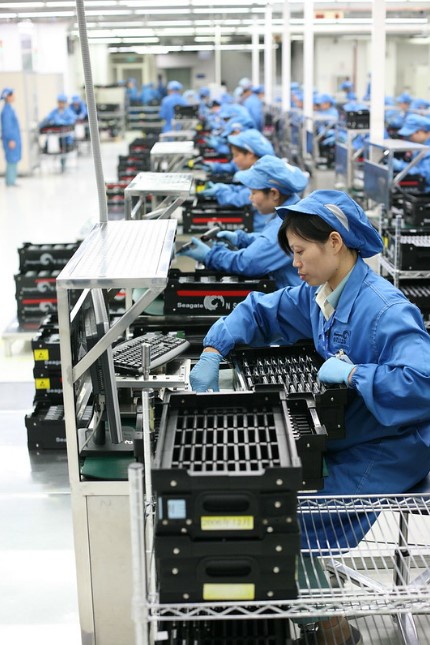 The modernisation of Chinese industries has made China into one of the biggest industrial nations / Image: Robert Scoble
The modernisation of Chinese industries has made China into one of the biggest industrial nations / Image: Robert Scoble
What industrial development we’ve seen on a world scale over the past 30 years has taken place largely in China, which has emerged as a new world power. Since the mid-1990s, China’s labour productivity has grown by 7 to 10 percent annually.
After initially hailing the Chinese economic success, and leaning on China to recover from the 2008 crash, the US and the EU started to become concerned about Chinese growth. They started noticing how Chinese companies took a serious interest in patents and intellectual property. This ranged from agriculture to electronics. Chinese companies like Lenovo, Geely and Huawei were also acquiring companies and market shares in the West. And so the western powers started to worry.
Already by Obama’s presidency, there was talk of a ‘Pivot to Asia’, but after the announcement of the ‘Made in China 2025’ plan in 2015, quantity turned into quality. China became a serious worry and during Trump's presidency, the US began a serious attempt to hold back China’s development.
‘Made in China 2025’ was an announcement to the world that China was no longer content with producing merely furniture and clothes, and assembling electronics. It wanted to compete in the most advanced technological sectors and reduce its dependence on foreign suppliers.
China has a massive population, and the value of the total output of its economy is now approaching that of the US. The modernisation of Chinese industries has made China into one of the biggest industrial nations. However, China still lags far behind. The IMF estimates that its average labour productivity in industry is 35 percent of that of global best practices.
Only in the most advanced areas, like the cities around the Pearl River Estuary, Shanghai or Beijing, do you get a GDP per capita which is comparable to Spain or Portugal. China is not on par with advanced imperialist countries like Germany, Japan or the US, but it has laid out its ambition to become so.
The US is now leveraging its economic and diplomatic power to stop countries exporting key components to China and buying technologies like 5G from Huawei. It also has set itself the task of ‘liberating’ its supply chains and those of its allies from China.
Many of its allies remain unconvinced by their approach. Indeed, Scholtz, contrary to the wishes of the US, decided to make a visit to Xi Jinping. He was determined to resolve Germany’s disputes with China independently of the US. Macron has a very similar approach, and the communique of ‘agreements’ after his recent meeting with Biden, notably did not mention China.
The smaller EU powers are unhappy with the way the conflict with Russia has been handled by the US: twisting their arms to take measures that have a limited impact on the US economy, but are very heavily damaging European industry, in particular that of Germany. One anonymous senior EU official called it a “historic juncture” in the EU-US relationship (Europe accuses US of profiting from war – POLITICO). The European powers fail to see the allure of another trade war in which they must abide by US dictates.
Yet the US is quite capable of taking unilateral action, and it has continued to do so. It is imposing new legislation, not just on US companies but on any company in the world. The recent ban on the export of machinery to produce semiconductors to China is one such example. Similarly, in its blockade against Cuba, the US has unilaterally demanded compliance from companies in Europe, Taiwan, etc., or risk being sanctioned in turn.
The world’s biggest producer of semiconductors is a Taiwanese company called TSMC. It now has to apply for permission from the US government to import machinery to its plants in China. The largest producer of such machinery is ASML, a Dutch company. The Dutch government is now in discussions with the US about what additional barriers to impose on exports to China. The US is essentially forcing its methods of ‘competition’ with China onto its allies.
The US remains the super power, and just as the British fleet back in 1914 had a policy of maintaining a naval capacity larger than its two biggest competitors combined, so the US is spending as much as the ten following nations combined on its military, or 2.7 times that of China, which comes in second. In the past, this power was used to keep free trade flowing. But increasingly, it is now being used for the opposite purpose.
This turn in the US has major implications. Unlike in the past, its power is no longer used to defend the general interests of the capitalist class against the Soviet Union or world revolution, but its own narrow interests against the other major powers. It has thus taken up the role of a declining power, attempting to shield itself from competition, somewhat like Britain at the end of the 19th century.
Yet it would be quite wrong to see protectionism merely from a US perspective. The European Union also has an interest in countering Chinese competition. They have their own “Chips Act”, their own attempts to secure battery plants for lithium batteries, and so on. The Chinese government has limited new protectionist initiatives, but there are plenty of complaints about unofficial measures taken to make life difficult for Western companies operating in China.
All these conflicts are intensifying under the pressure of events. This will have major consequences. Refashioning supply chains to avoid Russia and China will be tremendously expensive. The attempt to move microchip production apparently means investment in lithography systems to the tune of $300 billion from TSMC, Intel and Samsung. According to ASML, TSMC has already announced investment plans of $100 billion. Once established, these new factories will have to be protected against foreign competition by tariffs and other measures. The fact that they are all likely to overshoot the demand of the world market for semiconductors, with consequences for prices, makes this particularly true. Thus, protectionism feeds protectionism.
This will have long-term consequences for levels of investment. The IMF estimated that every point reduction in tariffs resulted in a 0.4 point increase in investment, because of the cheapening of machinery. Now, increased protectionism will lead to more expensive machinery and thus less investment.
In this scramble, world trade will not cease. How can it? But it will become more expensive, which will mean more expensive goods, i.e. more inflation. This will have to be countered then by the raising of the interest rates to try to cool down the economy, which will in turn provoke recession.
Why are they doing it, one might ask? Certainly the liberal press asks this time and time again. Yet it is not hard to find the reason. Firstly, it is the policies of free trade that have led us precisely to this point. Free trade both postponed and also massively exacerbated the crisis. Neither free trade nor protectionism can resolve the contradictions of capitalism.
Secondly, in increasingly harsh economic conditions, governments are trying to find some kind of way of stabilising the political system and ensuring that the main monopolies retain or gain an edge over the competition. They attempt to buy themselves a bit of time, so that if revolutionary convulsions will collapse a regime, they can ensure it won’t be their regime. Yet, because they’re all acting in the same way, they destroy the fabric of the world economy, and by extension, of the capitalist system as a whole.
Where do Marxists stand?
The market, or the ‘invisible hand’, played a historically progressive role, but is clearly unable to do so any more. For us it’s not a question of supporting free trade against protectionism. It’s not our role to try to turn the clock back to 2006 or even to 1967. The whole crisis shows the inability of capitalism to take humanity forward, and in its senile decline, capitalism is destroying many of the gains it had made in the past.
It is destroying its supply chains, it’s destroying its system of international relations, it’s returning us to wars, militarism and all the associated waste in economic resources and human life. Our role is to explain why this is taking place, and how neither side will solve anything by their measures.
We must understand that protectionism is a dead end. The whole development of the past 80 years shows the complete reactionary utopia that was ‘socialism in one country’. We are one interconnected globe and there are huge advantages for us in sharing experiences, technology and resources. Socialism would be built on a foundation of trade and internationalism, not by forcing the productive forces into the straight jacket of the nation state.
Free trade and liberalisation can no longer take us one step forward, whilst the turn to protectionism just makes things worse. We are socialists, Marxists and revolutionaries. We see in this collapse of globalisation only another stage in the crisis of the system as a whole. We see the great benefits of world trade, but this path is now finished. Only on the basis of the working class taking power can we re-establish world trade and world relations on a healthy basis. We will prepare the way for a massive leap forward.

